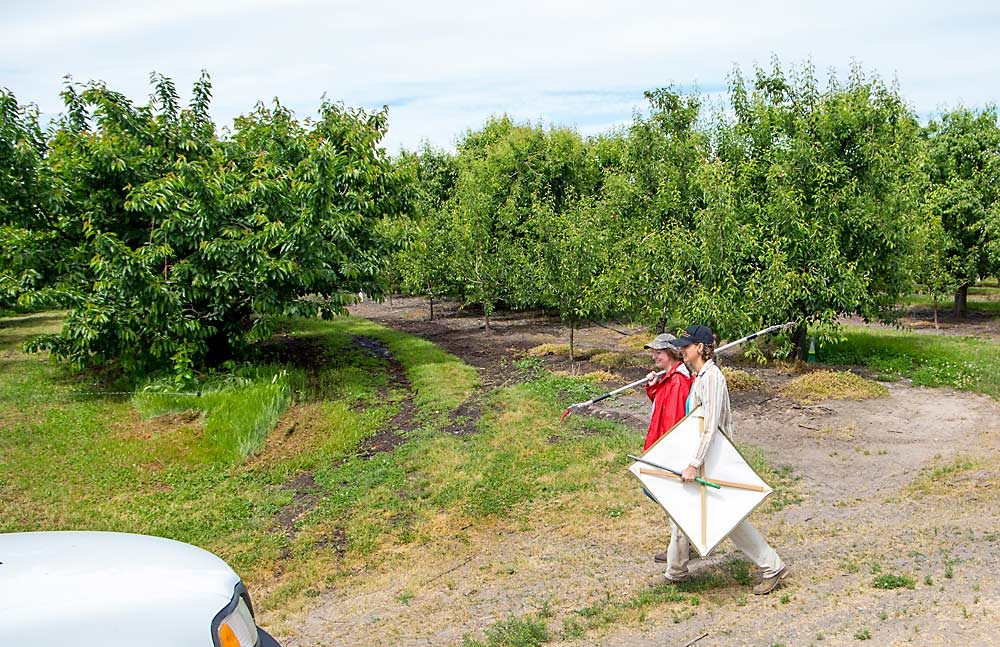
What lives in one orchard may affect integrated pest management in a neighboring orchard, even if it’s a different crop.
That doesn’t sound so surprising, but a group of Hood River, Oregon, orchardists asked a researcher to explore how much the pest management in cherry orchards may throw off the IPM of neighboring pear blocks.
The answer is some, said Dalila Rendon, an Oregon State University entomologist. Not much, but just enough to warrant exploring the topic further.
“In general, the relationships were very weak,” she said.
Growers in the Hood River area, where pear and cherry blocks form a patchwork landscape, suspected that aggressive management programs for spotted wing drosophila in cherry orchards might have a ripple effect on the careful balance of IPM in neighboring pear orchards.
They are glad Rendon confirmed the connection, even if slightly, said Mike Doke of Columbia Gorge Fruit Growers, which represents area growers.
“Our fears aren’t allayed or anything, but we agree with her conclusion that we need to know more,” Doke said.
The group’s growers have documented the problem beyond a hypothetical fear, he said. In fact, the organization asked Rendon to take up the issue, helped fund it and hopes another entomologist continues to study it.
The group funded Rendon’s work at $12,400 and was poised to award a similar amount for 2019. However, in March, Rendon left the Hood River area for a courtesy research faculty position with OSU in Vienna, Austria.
“I think there are growers who are convinced, and they want to know more about it,” Doke said.
Rendon analyzed survey data from three years in pear orchards in the area, looking for beneficial insects: trechnites, campylomma, deraeocoris, orius, lacewings, lady beetles, ants, damsel bugs, earwigs and spiders.
In 2016, pear orchards near cherries, within a kilometer, had a tendency to have fewer beneficials. In 2018, she noticed only small-scale effects that differed somewhat from 2016. When cherry orchards were in the same surrounding area as pear blocks, they didn’t seem to affect populations. But when pears were right next door to cherries, they had higher populations of both pests and beneficials.
She and her colleagues did not find any of the same relationships in 2017.
Her message to growers: Don’t sweat the small stuff, and the proximity of pear and cherry orchards seems to be small stuff.
“I told (growers) that I would not worry too much about the cherry neighbors, as there are other factors that will more likely influence psylla and beneficial abundance,” she said.
However, she also uncovered a few interesting details that warrant further exploration.
For one, the relationships were not consistent each year and she didn’t know why. Also, location and elevation seem to provide a stronger effect, she said. Higher elevation sites near Parkdale — to the south, near Mount Hood — showed a lower variability on beneficial abundance than lower, northern sites near the Columbia River.
“To me this suggests that other external factors may have a higher influence on beneficial abundance at these northern sites than at southernmost sites,” she said. Among them may be the heterogeneity of landscape, level of urbanization, proximity to water and unmanaged areas, or even differences in soil
It doesn’t bother her that the connections were nuanced and tenuous. Research often is that way and people shouldn’t wait for eye-popping figures to pay attention, she said.
“As a scientist, I firmly believe that all data is important, and all results are important,” she said. “The bias toward significant results is a disservice to science and environmental policy.” •
—by Ross Courtney






Leave A Comment